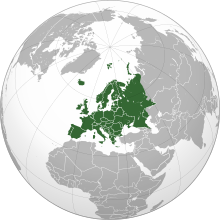Europe
 |
|
| Area | 10,180,000 km2 (3,930,000 sq mi) (6th) |
|---|---|
| Population | 742,452,000 (2013; 3rd) |
| Pop. density | 72.9/km2 (188/sq mi) (2nd) |
| Demonym | European |
| Countries |
50 sovereign states 5 with limited recognition |
| Dependencies | 4 dependencies |
| Languages | ~225 languages |
| Time zones | UTC−1 to UTC+5 |
| Largest cities |
|
Europe is a continent that comprises the westernmost part of Eurasia. Europe is bordered by the Arctic Ocean to the north, the Atlantic Ocean to the west, and the Mediterranean Sea to the south. To the east and southeast, Europe is generally considered as separated from Asia by the watershed divides of the Ural and Caucasus Mountains, the Ural River, the Caspian and Black Seas, and the waterways of the Turkish Straits. Yet the non-oceanic borders of Europe—a concept dating back to classical antiquity—are arbitrary. The primarily physiographic term "continent" as applied to Europe also incorporates cultural and political elements whose discontinuities are not always reflected by the continent's current overland boundaries.
Europe covers about 10,180,000 square kilometres (3,930,000 sq mi), or 2% of the Earth's surface (6.8% of land area). Politically, Europe is divided into about fifty sovereign states of which the Russian Federation is the largest and most populous, spanning 39% of the continent and comprising 15% of its population. Europe had a total population of about 740 million (about 11% of world population) as of 2012[update].
...
Wikipedia
